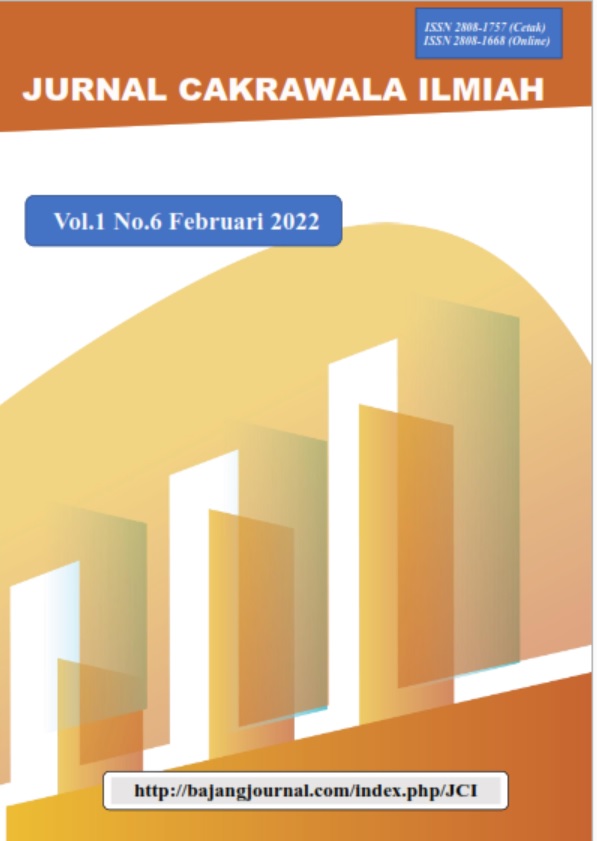THE IMPACT OF E-COMMERCE TOWARD CONSUMER PURCHASE INTENTION AT UD.CIPTA PRIMA MEDAN
DOI:
https://doi.org/10.53625/jcijurnalcakrawalailmiah.v1i6.1515Keywords:
E-Commerce, Consumer Purchase IntentionAbstract
This study empirically examines the website attributes in ecommerce influencing customer purchase intention. The writer do the observation and preliminary data that UD. Cipta Prima Medan is having problems which the manager says that there is no consumer purchase intention and most of the customers are only came from North Sumatra. The population that the writer used is the purchasing customers in UD. Cipta Prima Medan, which is 45 customers. The writer uses convenience sampling technique in which the sample are selected because readily available and convenience. In analyzing data, the writer used some methods such as statistics, normality test, validity test, reliability test, correlation test, determination test, linier regression, and hypothesis test. Based on statistical calculation and analysis, the data is highly valid and the questionnaire is reliable. The Pearson correlation coefficient is 0,87 and the determination is 75.20%. This means that there are high and positive relation between E - Commerce and consumer purchase intention. The linear regression equation of this variable is Y = -3.54 + 1.28X. The Zcount of this skripsi is 5,8 and Ztable 1,96. Since Zcount > Ztable, hence Ha is accepted. This means that E- Commerce has an impact toward Consumer purchase intention at UD. Cipta Prima
References
Cooper, C. R., & Schindler, P. S. (2010). Business Research Methods (10 ed.). Boston: McGraw-Hill.
Cooper, C. R. & Schindler, P,S. (2013) Business Research Methods (12th Edition). New York: McGraw-Hill Education.
Gray, D.E. (2004) Doing Research in the Real World. London: Sage.
Hsu, C. L., Chang, K. C., & Chen, M. C. (2012). The Impact of Website Quality on Customer Satisfaction and Purchase Intention: Perceived Playfulness and Perceived Flow as Mediators. Information Systems and e-Business Management, 10(4), 549-570.
Ilagan, S.V. (2009).Exploring the Impact of Culture on the Formation of the Trust in Internet Shopping. Department of Communication and Journalism and of the Faculty of Graduate Studies of the University of Wyoming.
Jackson.(2012).Research Methods and Statistics : A Critical Thinking Approach. Wadsworth, Cengage Learning, USA.
Kotler, P. (2010).Marketing: An Introduction (10th Edition). USA: Prentice Hall Lamb,et al.(2009). MKTG, Canadian Edition. Canada: Nelson Education Ltd.
Luo et al.(2012). The Effectiveness of Online Shopping Characteristics and WellDesigned Websites on Satisfaction. MIS Quarterly, 36(4), 1131-1144.
Sekaran, U., & Bougie, R. (2011). Research Methods for. Business: A Skill Building Approach. London: John Wiley & Sons. Zaman,H.B. (2013) . Advances in Visual Informatics: Third International Visual Informatics Conference, IVIC
Casalo,L. (2007).The Impact of Participation in the Virtual Brand Communities of Consumer Confidence and Loyalty: The Case of Free Software. Online Information Review, Vol.31, No. 6, Pp. 775–792.
Dodds et al. (1991). Effects of Price, Brand and Store Information on Buyers’ Product Evaluations. Journal of Marketing Research, 28(August), 307-319.
Hausman, A.C. & Siekpe, J.S. (2009).The Effect of the Features of the Web Interface on the Consumption Online Purchase Intentions. Journal Business Research, Vol. 62, No. 1, Pp. 5–13.
Jaafar et al. (2013). Consumers’ Perceptions, Attitudes and Purchase Intention towards Private Label Food Products in Malaysia. Asian Journal of Business and Management Sciences. Vol. 2, No.8, pp. 73-90 .
Kawa et al.(2013).Factors Affecting Consumer Decision Making: A Survey of Young Adults on Imported Cosmetics in Jabodetabek. Indonesia: The SIJ Transactionson Industrial, Financial & Business Management (IFBM), Vol. 1, No. 5, November-December 2013.
Keller, K.L. (2001). Building customer-based brand equity. Marketing management. Vol. 10(2).pp.14-19.
Keeney, R.L. (1999). The Value of Electronic Commerce on the Internet for the Consumer. Management Science, Vol. 45, No. 4, Pp. 533–542.
Kuo, H. M., & Chen, C. W. (2011). Application of quality function deployment to improve the quality of Internet shopping website interface design. International Journal of Innovative Computing, Information and Control, 7(1), 253-268. Lee et al. (2010). Perceived price fairness of dynamic pricing. Journal of Industrial Management & Data Systems, 111, 531-550.
Leelayouthayotin,L.(2004). Factors Influencing Online Purchase Intention: The Case of the Health Food Consumers in Thailand. Retrieved May 12, 2014 from http://eprints.usq.edu.au/149/1/Thesis_August_04.pdf
Pavlou, P. A. (2003). Consumer acceptance of electronic commerce: Integrating trust and risk with the technology acceptance model. International Journal of Electronic Commerce, 7(3), 69-103.
Ranganathan, K. , Dey, R. & Ganapathy,S. (2002). Key Dimensions of Business-toConsumer Sites. Information and Management, Vol. 39, No. 6, Pp. 457–465.
Rozekhi, N. A., Hussin, S & Noor, A. M. (2014). Attributable E-commerce towardPurchase Intention: Online Search of Food Product. The SIJ Transactions on Industrial, Financial & Business Management (IFBM), Vol. 2, No. 3, May 2014.
Shah et al.(2012). The Impact of Brands on Consumer Purchase Intentions. Asian Journal of Business Management, 4(2): 105-110
Zhang et al. (2011). Repurchase intention in B2C e-commerce - A relationship quality perspective. Information & Management, 48(6), 192-200. Retrieved January 11, 2011 from http://dx.doi.org/10.1016/j.im.2011.05.003
















